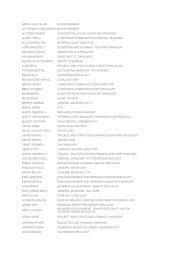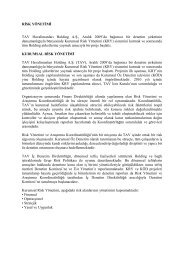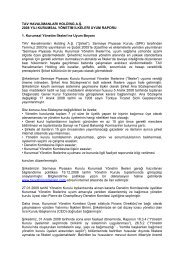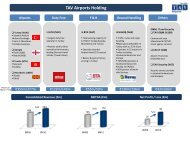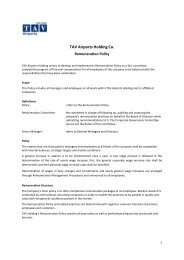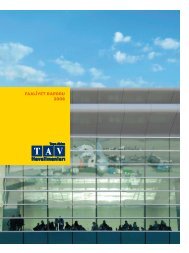TAV IT
TAV IT
TAV IT
You also want an ePaper? Increase the reach of your titles
YUMPU automatically turns print PDFs into web optimized ePapers that Google loves.
148<br />
<strong>TAV</strong> Airports Holding Annual Report 2008<br />
<strong>TAV</strong> AIRPORTS HOLDING AND <strong>IT</strong>S SUBSIDIARIES<br />
NOTES TO THE CONSOLIDATED FINANCIAL STATEMENTS<br />
AS AT AND FOR THE YEAR ENDED 31 DECEMBER 2008<br />
(Amounts expressed in Euro unless otherwise stated)<br />
The Group has procedures in place to ensure that services are provided to customers with an appropriate credit history. The carrying<br />
amount of trade and other receivables, net of provision for impairment of receivables, and the total of cash and cash equivalents,<br />
represents the maximum amount exposed to credit risk. The Group has no significant concentration of credit risk since the<br />
customers portfolio is diversified among a number of customers and the main customer is Turkish Airlines (“THY”) which is the flag<br />
carrier and one of the most reputable firms in Turkey. Although collection of receivables could be influenced by economic factors,<br />
management believes that there is no significant risk of loss to the Group beyond the provisions already recorded due to, reputation<br />
and type of customers for the airlines (well-known reputable, international and flag carrier companies), method of sales which is<br />
cash or credit card basis for duty free sales.<br />
In addition, the Group receives letters of guarantee, and notes from some customers whose credibilities are low.<br />
Liquidity risk<br />
Liquidity risk is the risk that the Group will not be able to meet its financial obligations as they fall due. The Group’s approach to<br />
managing liquidity is to ensure, as far as possible, that it will always have sufficient liquidity to meet its liabilities when due, under<br />
both normal and stressed conditions, without incurring unacceptable losses or risking damage to the Group’s reputation.<br />
The Group uses activity-based costing to cost its products and services, which assists it in monitoring cash flow requirements and<br />
optimising its cash return on investments. Typically the Group ensures that it has sufficient cash on demand to meet expected<br />
operational and financial expenses, including the servicing of financial obligations; this excludes the potential impact of extreme<br />
circumstances that cannot reasonably be predicted, such as natural disasters.<br />
Market risk<br />
Market risk is the risk that changes in market prices, such as foreign exchange rates, interest rates and equity prices will affect the<br />
Group’s income or the value of its holdings of financial instruments. The objective of market risk management is to manage and<br />
control market risk exposures within acceptable parameters, while optimising the return.<br />
The Group buys and sells derivatives, and also incurs financial liabilities, in order to manage market risks. All such transactions are<br />
carried out within the guidelines set by lenders and executives of the Group as mentioned in Note 36.<br />
i) Currency risk<br />
Currency risk is the risk that the value of financial instruments will fluctuate due to changes in foreign exchange rates. The Group<br />
has exposure to the effects of fluctuations in the prevailing foreign currency exchange rates on its financial position and cash flows.<br />
As at 31 December 2008, the Group had balances that are denominated in a currency other than the respective functional currencies<br />
of Group entities, primarily the Euro, but also USD, GEL, Tunusian Dinar and TRY which are disclosed within the relevant notes to<br />
these consolidated financial statements. The Group manages this currency risk by maintaining foreign currency cash balances. The<br />
currency risk is managed by using of some financial intruments as mentioned in Note 38.<br />
ii) Interest rate risk<br />
The Group adopts a policy of ensuring that between 80 and 100 percent of its exposure to changes in interest rates on borrowings is<br />
on a fixed rate basis. This is achieved by entering into interest rate swaps as mentioned in Note 38.






